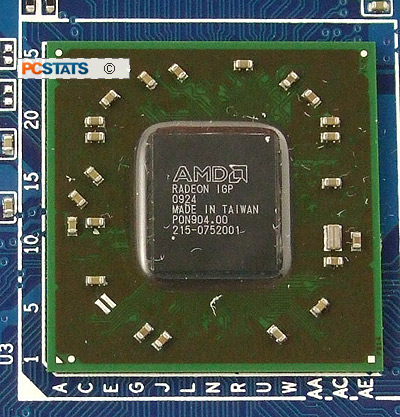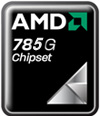
|
The Gigabyte GA-MA785G-UD3H motherboard mixes things up a little and nicely illustrates the flexibility of AMD's Phenom II and Athlon II processors - DDR3 and DDR2 memory compatibility.
72% Rating: 
|
|
|
|
Home >
Reviews >
Motherboards >
Gigabyte GA-MA785G-UD3H |
|
|
Introducing the AMD 785G / Radeon HD 4200 chipset
Introducing the AMD 785G / SB710
Chipsets 
The AMD
785G and SB710 chipsets bring support for DirectX 10.1 and Windows 7 to the AMD processor
platform, not to mention a new slightly improved Radeon HD 4200 IGP which is clocked
at 500MHz.
The Radeon HD 4200 offers hardware-acceleration for
certain kinds of video transcoding, so the AMD 785G can best be seen
as an all-around incremental improvement to the AMD 780G which proceeded
it.
The AMD 785G
chipset also continues AMD's strategy of having cross-compatiblity support for a huge range of processors,
and it can work with either DDR2 or DDR3 memory.
The centerpiece of the AMD
785 chipset is the Radeon HD 4200 IGP. This new graphics core is very similar to
the Radeon HD 3200 that powered the AMD 780G. Both IGPs are built on a 55nm
process, have 40 stream processors, and contain ~205 million transistors. Performance of the
500MHz Radeon HD 4200 IGP should be largely identical to AMD's previous IGPs, with
the key changes being support for DirectX 10.1 and Shader Model 4.1.
 Should
you want to use a stand alone videocard the AMD 785G chipset supports a PCI Express
2.0 x16 slot, and can be used in Hybrid Crossfire mode with selected
ATI Radeon graphics cards. In ideal situations, this will double the performance of
the Radeon HD 4200 IGP. Should
you want to use a stand alone videocard the AMD 785G chipset supports a PCI Express
2.0 x16 slot, and can be used in Hybrid Crossfire mode with selected
ATI Radeon graphics cards. In ideal situations, this will double the performance of
the Radeon HD 4200 IGP.
Further improvements include new hardware-accelerated transcoding support for selected
video applications. ATI Stream lets the Radeon HD 4200 GPU
accelerate media encoding. Unified Video Decoding uses the GPU to decode video, reducing load
on the CPU as well.
AMD's Radeon
HD 4200 supports HDMI, Displayport, DVI
and Analog VGA outputs, so again flexibility is key. Digital video signals are HDCP
compliant, so it's fully compatible with high-definition content played over
Blu-ray discs.
The
integrated Radeon HD 4200 videocard contains 40 stream processors and shares up to 512MB of
installed system memory, some platforms include dedicated SidePort memory. The AMD 785G supports
up to six PCI Express 2.0 x1 slots along with
six PCI bus mastering slots, although it's up to the motherboard manufacturer to implement
each expansion slot.
The AMD's 785G chipset is a
real challenger to Intel's G41/G45 Express chipsets, although only time will tell
how it fares to next-generation chipsets like Intel's G55 Express.
ATI Stream Technology
ATI Stream aims to allow the programmable stream processors of Radeon
GPUs do the work of a CPU, in a very similar fashion to NVIDIA's CUDA
technology. There are certain intensive tasks that are easy to optimize for the
massively parallel nature of an IGP like the Radeon HD 4200 that can cause even the fastest
CPUs to choke and stall. ATI has been working with developers like Adobe
and Microsoft so programs can take advantage of a dedicated GPU in a desktop
environment.
The latest version
of ATI Stream has added a new video transcoding technology that lets
the Radeon IGP to accelerate video encoding. Video encoding remains a very
intensive task, and ripping a DVD to play on an iPod can take hours
depending on the video quality and length of the movie.
Acceleration support is still quite
limited at this point, with only certain codecs (H.264, MPEG2, VC1) and programs
(Cyberlink Espresso, ATI Video Converter, Arcosoft Total Media Theatre)
supported. Hopefully as this technology evolves it will become more widely
supported and turn full hardware acceleration for the desktop into a reality.
Power
Savings
Integrated
chipsets under Microsoft Windows 7 will now have better support for power saving technology, and the
Radeon HD 4200 capitalizes on this with dynamic underclocking that will reduce the speed of the
GPU based on how much load is being used.
How does the Gigabyte GA-MA785G-UD3H fare during Blu-ray HD video playback?
Let's find out!
AMD 785G HD and Blu-Ray playback
tests
With HD video decoding becoming increasingly common
and Blu-Ray becoming a standard technology in computer systems, it's important
for graphics chipsets to not only support high-definition output formats, but
also have hardware support for intensive CPU-decoding as well.
AMD's 785G chipset makes use of 'Unified Video
Decoder', which directs HD playback decoding to the integrated Radeon HD 4200
GPU, rather than to the AMD processor, allowing the system to playback VC-1,
MPEG-2 and H.264 content up to 1080p resolution with less CPU usage.
The rear I/O of the Gigabyte GA-MA785-UD3H has DVI (maximum
resolution of 2560 x 1600), HDMI (1920 x 1080), and VGA (2048 x 1536). The DVI
output can be used in conjunction with either the HDMI or VGA output for
multiple monitor output.
 Blu-Ray Disc HD
Playback Blu-Ray Disc HD
Playback |
|
| |
Blu-Ray High Definition content demands a lot of PC processing resources
during playback, if CPU load becomes too high that can lead to jittery video
quality or other artifacts. Many integrated graphics processors now feature
Blu-Ray and High Definition H.264, VC1 and M-PEG2 content acceleration decoders
to offload this processing from the CPU, freeing up system resources for other
tasks.
The PCSTATS Blu-Ray HD content playback test scenario monitors average CPU
utilization. It's simple and to the point. The motherboard's integrated graphics
processor is taxed in the same way it would be in your home theatre environment,
and average percent CPU utilization monitored with Windows task manager. Lower
CPU utilization values are best, provided video playback remains smooth and
stutter free.
How PCSTATS Tests: Each integrated graphics motherboard is
connected to an ASUS MK241 wide screen 1920x1200 (1080P) resolution LCD display with an
HDMI cable. The Blu-Ray movie "10,000 BC" (VC1 encrypted) is then
played back from Chapter 22 on an ASUS BC-1205PT Blu-ray combo drive, using WinDVD Platinum software and the average
fluctuation of CPU load recorded. Lower results are better.
 Blu-Ray Content Playback
Tests (BR-DVD) Blu-Ray Content Playback
Tests (BR-DVD) |
| Integrated Graphics Solution: |
% CPU Utilization |
Ranking |
| Intel GMA X4500HD |
32 - 38% |
   |
 AMD HD 4200 AMD HD 4200 |
7 % |
   |
| AMD HD 3300 |
6 - 14% |
   |
| Nforce 750a |
18 - 20% |
   | |
Under testing the Blu-Ray
playback wasn't a huge tax on the AMD 785G chipset. While Intel's G45 chipset
paired with a Core 2 Duo E6750 stayed at around 30 to 40% CPU load, the AMD 785G
chipset stayed consistently under 30% load while playing back high-def content.
 Hard Drive HD
720p/1080i Playback Hard Drive HD
720p/1080i Playback |
|
| |
Playing high definition
content on current generation PCs can bog down even the fastest processors
because there is more data to handle. To test the integrated graphics
processor's capabilities at HD content accelerating capabilities, we played the
High Definition video clip, "The Discoverers" at 720P and 1080i from the hard
drive while monitoring the percentage of CPU utilization through Task Manager.
Lower results are better.
The AMD 785G chipset does an excellent job of taking the
brunt of HD decoding away from the processor. It should be easy to run
background processes and watch HD video at the same time.
ATI Stream Technology /
Hardware Accelerated Transcoding
To test out the new ATI Stream hardware acceleration,
PCSTATS chose Cyberlink's MediaShow Espresso. It's a transcoding
program that can take advantage of both CPUs and GPUs in order to convert video
files from one format to another. MediaShow Espresso has a very simple interface
for adding new files and several transcoding presets. PCSTATS tested MediaShow
Espresso with the trailer for Pixar's movie "Up!" The original file format was a
1920x1080 Quicktime.MOV file, encoded in H.264-avc1. The test file was
transcoded into a 1080p mpeg-2.
| Cyberlink
MediaShow Espresso Transcode Test |
Time to Transcode |
| Gigabyte GA-MA785G-UD3H with discrete graphics
(no hardware acceleration) |
2:16 |
| Gigabyte GA-MA785G-UD3H with Radeon HD 4200 IGP
(hardware acceleration enabled) |
2:13 |
As you can see, both the CPU and GPU work together in
these instances to accelerate encoding performance. While the Radeon HD 4200 IGP
isn't dramatically decreasing encoding time with this short video, it is shaving
off a few seconds off every encode. The faster the processor, the more
pronounced the effect of having hardware accelerated decoding becomes.
Next up, overclocking the motherboard and IGP, that's a
first!
|
